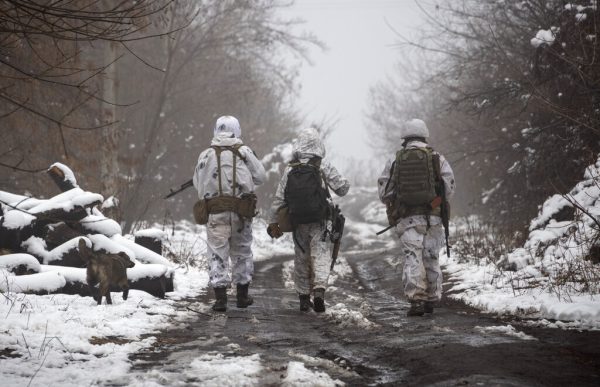
Though history never exactly repeats, the parallels of the current U.S.-China-Russia dynamic to the pre-World War II years are remarkable. “Intensifying competition between revanchist autocratic powers and an overextended democratic one?” Check. “A battle to shape the global narrative and dominate access to vital strategic resources?” Check. “The growing prospect of a two-front global conflict breaking out in quick succession in both Asia and Europe?” Check.
Like pre-WWII Britain and France, the U.S. has become a woefully overstretched globe-straddling hegemon whose inward-looking population is feeling the financial and social strain of its foreign commitments. As in the 1930s, today’s democratic world faces powerful European and Asian foes. Russia and China each have their own set of historic grievances and the determination and military means to act on them. Most alarming of all, however, is the striking resemblance that Xi Jinping’s quest to engulf Taiwan bears with Hitler’s ultimately successful drive to bring Czechoslovakia’s Sudetenland into the German Third Reich. There are more possible parallels, but let us turn now to two key factors which differ from the 1930s, for herein lie our best options for avoiding a cataclysmic global conflict.
Putin is no Stalin
Though Russian President Vladimir Putin is a meddlesome force in global politics, and admittedly a gifted strategist, his nearly three decades in power show he is not an imperious and genocidal leader in the mold of Stalin. He is akin to a cunning crime boss determined to preserve a syndicate of lucrative and illicit monopolistic ventures run by his group of oligarchic cronies. We must remember that, though overly ruthless, Putin is not the first person to oppose NATO expansion. Indeed, every former Russian leader was dead against it, including pro-Western reformer Boris Yeltsin. Unlike Yeltsin, however, Putin has total control over a revived Russian military, forcing Western powers to take him seriously.
If this assessment is correct, then it is high time for the democratic world put aside its rigid approach to contemporary Russia and instead adopt the lessons of “Realpolitik” as practiced by German chancellors Willy Brandt and Helmut Schmidt in the 1970s. Through pragmatic engagement with the Soviet Union and strategic deterrence provided by the U.S. and NATO, Realpolitik turned what would have been a devastating conflict in Europe into a tense but stable coexistence and eventually led to the end of the Cold War.
How does this lesson apply to Putin’s Russia in 2022? By deploying a permanent NATO strike force in Poland and Romania, Western democracies can continue to ensure the security and viability of an independent and democratic Ukraine without crossing any of Russia’s red lines. This common sense approach upholds both sides’ national interests and in no way condones Putin’s previous de facto annexation of the Donbas and the Crimea in 2014. Instead, it is a belated acknowledgment that today’s Russia does not (yet) represent the same existential threat to the democratic world’s core geopolitical interests as Xi Jinping’s China does. It is a forward-leaning strategy that will help avoid pushing Putin into an “alliance of necessity” with Xi. This partnership is certainly not in Russia’s long-term national interest, but it is disastrous for democracies, and must be discouraged at all costs.
Japan is Asia’s Diplomatic Heavyweight
The second major distinction between today and the 1930s is the existence of stable and powerful Asian liberal democracies in the form of Japan and South Korea, as well as dynamic stakeholders, such as Taiwan and the Association of Southeast Asian Nations (ASEAN), who have benefited from a vibrant regional economic order underpinned by the U.S. alliance system. East Asia in the 1930s, in comparison, was a kaleidoscope of monarchies, military dictatorships, and foreign-occupied colonies, on the verge of exploding with revolutionary and nationalistic fervor.
Xi’s narrative is that democracy is alien to Asia and unsuitable for the 21st century. Undoubtedly he wants to replace the American-led democratic order of the past 70 years with an autocratic model and a Beijing-centric economic world order, powered by China’s formidable commercial reach and technological prowess.
While many middle powers – among them, Indonesia, Vietnam, and Thailand – sit on the sidelines warily eyeing the gathering superpower storm, Japan is applying its own Realpolitik in confronting Xi by taking a principled and resolute stance in favor of a rules-based and democratic regional order.
Japan’s newfound leadership was brought about by the transformative Abe Shinzo, who continues to play a crucial behind-the-scenes role in influencing Japan’s newly muscular foreign policy. Recognizing early on the need to counterbalance China’s growing regional and global might and its ambitious Belt and Road Initiative, Abe formulated a political and economic counter-narrative centered around a coalition of Indo-Pacific democracies, known as the “Quad,” and made up of India, Japan, Australia, and the United States. Abe has also stressed the vital importance of safeguarding the survival of a democratic Taiwan, encouraging a slow but steady transition from the long-held U.S. and Japanese policy of “strategic ambiguity” to one of “strategic clarity.”
Given America’s current preoccupation with home-grown challenges to its social and economic stability, the decision by Japan to take the lead in confronting China’s increasingly aggressive designs in East Asia and its clearly stated intent to eventually take over Taiwan, could not have come at a more opportune time.
How these moves will play out on the global chessboard remains to be seen, but there is no doubt that leveraging Putin’s transactional mindset and Japan’s increasingly powerful stance will be crucial for deterring a future Chinese invasion of Taiwan and ensuring that the “Cold Peace” between China and the democratic world does not turn into a cataclysmic and global “Hot War.”
How Realpolitik 2.0 Can Prevent a Global Conflict
Source: Frappler

0 Comments